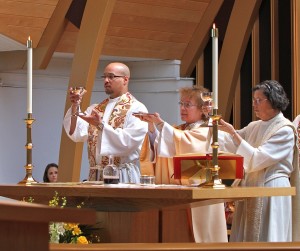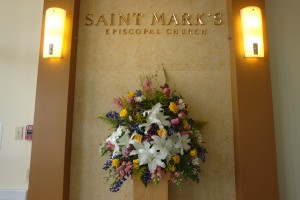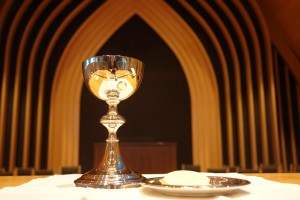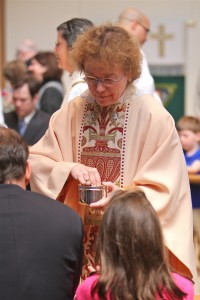The Regular Services
The principal service is the Holy Eucharist (Holy Communion). At Saint Mark’s it is celebrated twice each Sunday. The 8:00 Rite I (using formal, Elizabethan English) service is shorter, has less music, includes a sermon, and is followed by Christian Formation opportunities (September to May). The 10:30 Rite II (using contemporary English) service has more music (including choir from September to May), includes a sermon, and is followed by refreshments in the Parish Hall. Weekday celebrations also are frequently without music, and without sermon. When celebrated at a later hour on Sundays, or on other great Christian days such as Christmas or Easter, music and a sermon are customary, and incense (a “solemn” liturgy) is occasionally used. One major celebration of each holiday is always without incense, in consideration of those who may be sensitive.
All baptized persons are invited to receive Holy Communion in the Episcopal Church and those who are not baptized are invited to receive a blessing at the altar rail.
Another service is Morning Prayer. The parallel evening service is Evening Prayer. These services consist of psalms, Bible readings, and prayers; and may include a sermon. Often these services are done in the English choral tradition with full choir. Several times each year worship takes place in the Taize tradition.

While some parts of the services are always the same, others change. At the Holy Eucharist, for example, two or three Bible selections are read. These change each Sunday. So do the psalms. Certain of the prayers also change, in order to provide variety. Page numbers for parts of the service printed elsewhere in the Book are usually announced or given in the service leaflet. But do not be embarrassed to ask your neighbor for the page number.
You will find the services of the Episcopal Church beautiful in their ordered dignity, God-centered, and yet mindful of the nature and needs of human beings.
 Saint Mark’s is a member of the Episcopal Church of the United States. Episcopal means having bishops who are the leaders of the church and spiritual descendants of the very first apostles of Christ. The Episcopal Church is part of the world-wide Anglican Communion which includes those churches derived from the Church of England.
Saint Mark’s is a member of the Episcopal Church of the United States. Episcopal means having bishops who are the leaders of the church and spiritual descendants of the very first apostles of Christ. The Episcopal Church is part of the world-wide Anglican Communion which includes those churches derived from the Church of England. The Place of Worship
The Place of Worship In the pews you will find the Book of Common Prayer. It contains services for many occasions, and is the basis for the printed Order of Service which you received upon arrival. The large print is the actual service. The smaller print gives directions to ministers and people for conduct of the service.
In the pews you will find the Book of Common Prayer. It contains services for many occasions, and is the basis for the printed Order of Service which you received upon arrival. The large print is the actual service. The smaller print gives directions to ministers and people for conduct of the service.
 Vestments
Vestments Please join us
Please join us